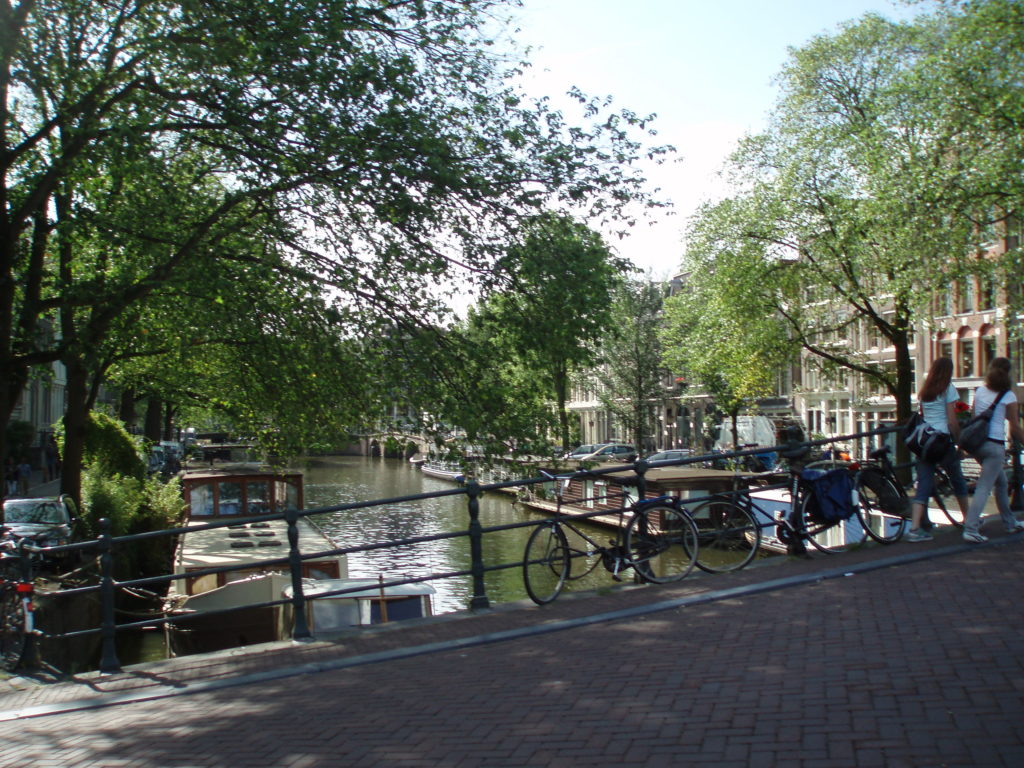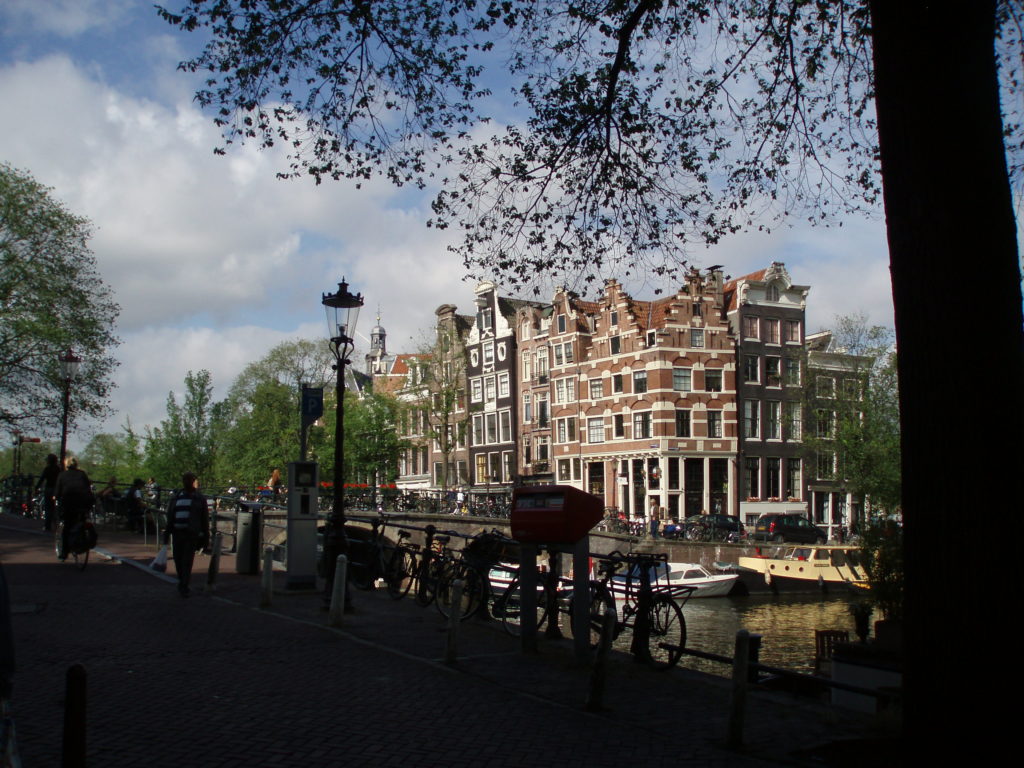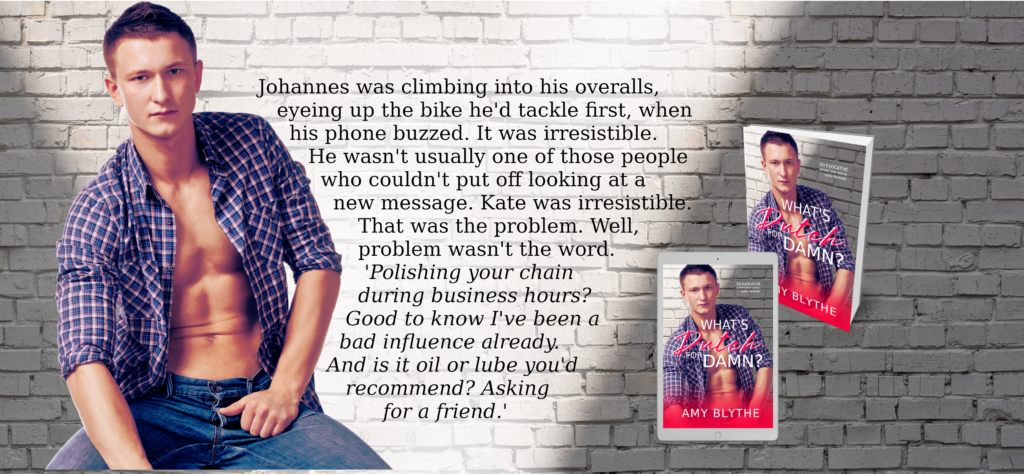Johannes’s Bike and Repair Shop
Our hero in What’s Dutch for Damn? is a little bit of a cliche, not gonna lie. He’s a cycling Dutchman. What’s more, he sells and fixes bikes for a living.
Is it a stereotype?

Is it doing any damage?
As someone with an in-house bike-whisperer (who happens to be Dutch) I’m willing to step out on a limb here and say cycling Dutchies are A-Okay.
Plus, they’re so damn proud of their bike-wielding.

One of the real perks of city living is being a bike-ride away from most anywhere you ever need to go. More-or-less. A little bit of exercise, on the way from A to B, is my favorite way to accidentally keep almost-fit.
Plus, you don’t have to deal with parking a car (or paying for the parking, or the car). And, increasingly, we have cycle paths. Cycling is safer and more relaxing when cars aren’t elbowing you into the gutter. For sure.
Obviously, biking is not an option for everyone, everywhere. But, if it is, I’d highly recommend finding a set of wheels and giving it a proper go.
Where do I start?
If you’re looking for a get-around-town bike then a mountain bike isn’t ideal. And a road bike might not be perfect either. Some key things to look for in a commuter bike:
- A chain guard. This encases the greasy chain, protecting your clothes from black grime, with the added bonus of keeping the weather off this part of the bike’s workings. The chain lasts longer and rarely needs oiling and, bonus, if you can find one with the gears in the hub (internal, as opposed to various-sized cogs and a clicky derailleur) then the chain is chunkier and will likely outlive you.
- Mud guards. Proper ones. These will prevent dirty water on the road from splashing up all over your clothes. Cyclists often get a muddy stripe, right up the butt crack. Like apocalyptic skid marks… not a great look, heading into the office of a morning.
- A tray on the back. You can strap a bag, basket or crate behind your seat, which means you needn’t wear a backpack. You’ll need a couple of bungee cords or something similar, to keep your luggage attached, but it will save you from a sweaty back, and generally keep you more comfortable on your ride.
Baskets, bags and all the bollocks
A front-basket is cute, but make sure it doesn’t obscure your headlamp. You’ll find that any substantial weight in the front basket can be a bit awkward, and if you go over a bump, you don’t want objects in your basket to fly up in your face.
Panniers are the best option, really. Basically, you want saddlebags. If you have a tray on the back you can probably attach one or two pannier bags, no problem.
The weight of everything you carry on a bike affects your balance. The lower you carry the weight, the safer you are. Commuter bikes tend to be much heavier than road bikes or mountain bikes – which is a good thing! Heavy bikes stick to the road. They’re less likely to skid out on gravel and, unlike a light-weight, skinny-tired road bike, you can cut across a grassy field without getting completely stuck.

You want to avoid being top-heavy. Carrying your laptop, a few groceries, that bottle of wine you picked up on the way home…? You want the weight hanging off your back wheel, nice and close to the road.
Bonus, you can keep any wet weather gear, fluoros, and gloves in the panniers. There is some risk of theft, but I’ve never had anything stolen and I always leave things in my panniers: a cheap waterproof anorak, a reflector vest, and gloves for cold nights are often necessary, I find. But you don’t want to be lugging them around all day – especially if they’re wet.
Let there be light!
A dynamo is also not essential, but if you can find one it’s handy. A bike needs lights for safe riding in wet weather and after dark. Even first thing in the morning, in winter, I sometimes use my headlamp and back light. You want these to be bright and reliable.
Running out of batteries makes for a risky ride home. A dynamo is a magical little beast that uses energy from the wheels to power your lights. You do have to pedal a little harder, but, voila! you’re making the lights shine. Ideally, find a light that stores a little bit of energy. My current model doesn’t do this and the lights turn off the moment I stop moving. It’s not a big deal, as usually I’m off the road or at well-lit traffic lights, but be aware: not all dynamos are equal.

This feels weird…
One of the main differences with a commuter bike is your posture. Mountain and road bikes tilt you forward, so you curl down toward the handlebars – which is great for aerodynamics and going fast, but not really comfortable.
When you’re commuting to work, or going out for dinner, the whole experience is different. You’re not actively trying to get a work-out, in fact you’re likely trying to not give yourself sweat-marks. The travel time is fairly predictable when traffic isn’t a factor – and when you’re cycling it’s honestly not. So, leave in plenty of time and have a leisurely ride to wherever you’re going. No hurry – no need to be fast and aerodynamic.
Honestly, let the low-slung Lycra-wearing legions pass you. They get a little thrill and you get to cycle in peace.
Commuter bikes often have wider, more comfortable seats, and lower bars between the seat and handlebars – so you can get on and off in your glad rags without flashing the whole street or ripping your fancy-pants.
The way you sit isn’t just good for your clothes and butt-comfort; it’s great for visibility too. Upright on the seat, other road-users are more likely to see you, and you’re more easily able to look around to see them.
If you’re one of the brave/crazy folk and like to ride hands-free, you’ll find a commuter bike ideal: the way you’d sit to balance, is the way you sit on a commuter bike anyway.
For the rest of us (with no desire for an adrenaline kick, of a morning) this posture simply means we’re more balanced. Things like signalling to turn, waving to friends, or pulling down a skirt, are not going to off-center us enough to unseat us.
What about maintenance and repair?
If you store a bike inside most of the time, it rarely needs anything done. The tires will deflate a little, over time, and you’ll notice pedaling gets a bit harder if they’re soft (more tire surface on the road = more friction). You will obviously need a tire pump. A big pump is usually less work to use, but you’ll need a place to store it at home.
A puncture kit is not really essential if you’re mostly doing short urban rides. If you get a puncture, and really cannot ride on, in most cities alternative transport is available: bus, uber, scooter, phone a friend. Just lock up your bike, and sort it out later (or take it with you on the bus).
I have never once patched a tire, so I won’t pretend to be any kind of expert here. Truth is, I’ve never had a puncture. I do have a plan, just in case: there’s a pump attached to my bike frame, and if I get a puncture I can pump the tire up and keep riding. If you can see the thing puncturing your tire (eg. a nail or bit of glass) it’s probably best to leave it in the tire as it’s plugging most of the hole.
As far as I understand, it has to be pretty bad to need immediate repair. I avoid cycling on broken glass – which is easier if you bike nice and slow, and even easier if your city is kind enough to provide you with off-road cycle paths.
Let’s talk helmet hair.
Obviously, this is a whole different issue from one cyclist to another. There are all different kinds of hair. If it’s a factor in your decision to get around on a bike, or not, I don’t blame you. I move through the world happier, with more confidence, when I know my hair looks like I meant it to look that way.

But there’s no magic trick here, no easy solution. I have fairly easy-to-deal-with hair, and my methods of hiding and fixing helmet-hair are probably not going to work for most people.
The law in New Zealand demands I wear a helmet on my bike, so I do. If the law changed, I would probably still use one on the road, but not on the cycle paths. That’s me, that’s my call.
In the Netherlands, when we biked places, no one wore helmets. It’s almost incomparable because every driver in every car is also a cyclist. On a bike in the Netherlands is safe as houses. One day, I hope, it will be that way in New Zealand too.
Most of the time, I have more issues with my skirt hiking up than my helmet hair.
In What’s Dutch for Damn? Kate and Johannes ride plenty – on their bikes! Get your mind out of the canal.
Or, you know, dive right in – plenty of bike-related double entendres await in What’s Dutch for Damn?

Pre-order is available now on Amazon, and it’ll be out 14 August on all e-book retailers!
In the meantime, What’s French for Oops? is only 99cents! Grab it on Amazon, or any other e-book retailer (including some libraries).


